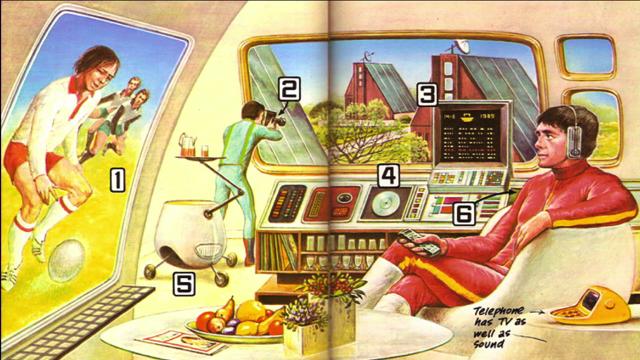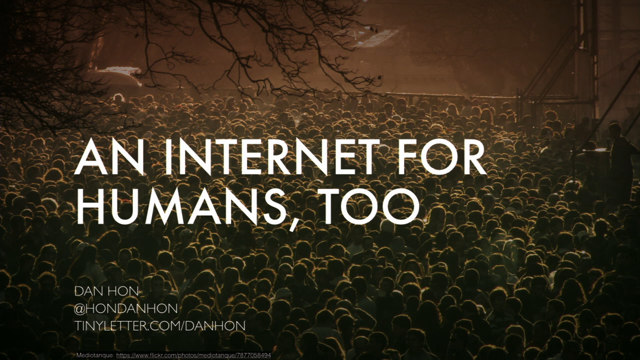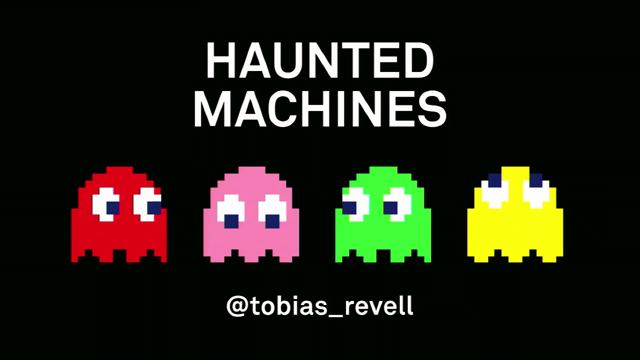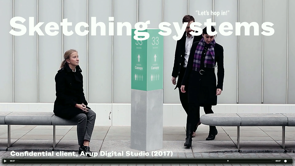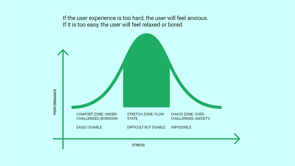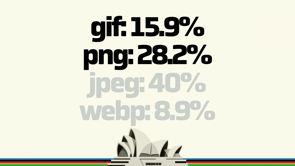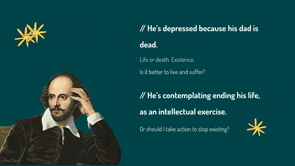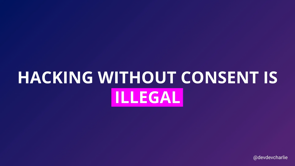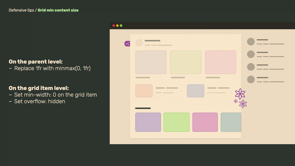Bridging the World through Cross-Cultural Creativity & Innovation

The Fail Whale
When Twitter goes down, people will see this image from 2008 to 2013. It creates an amazing community around the world. The community also came up with a name. They started to call it the Fail whale because it rhymes. It makes me very intrigued about the Chinese definition or etymology of fail.
The Art of Tech
Yi Ying Liu: Technology gives people like me a voice. Technology companies are using art as a vehicle to showcase difficult technology failure. It sort of kickstart this idea of integrating art and tech.
The Bridge to Bridge the Gap Between Fun and Function
One of my biggest passion is highlighting this three characters. It's highlighting the joy, the amusement and the light hearted nature of the work we do. I believe that visual language is a super language. It transcends the linguistic barrier. When you're introducing more colors and shapes, it also become more inclusive.
Building a Bridge Between China and Disney Shanghai
Disney opened their resort in 2016 in Shanghai, which is my hometown. How would I be able to create something that really be authentically Disney and distinctly Chinese? How do I have a unified voice for these five characters to be appealing to the Asian audience?
The Making of The Lion
And then the second one was Simba. The design is integrating with the little simba with the adult simba. I wanted to integrate and make it more universal and do a better hairdo.
Three Chinese characters for the film
The third one is Mulan, which is also really fun to work on because Mulan stands for courage. We wanted to infuse some sort of Western ideology. How am I going to make something quite Chinese into something Western?
Three bridges between Disney and art
And then the last one was the female leadership, Snow White. Third project I'm also very excited to share with you, which is bridging the gap between the tech and art. Shanghai Disney project was one of my favorite projects.
The Story of Emojis
The word emoji actually has nothing to do with emotion. It's the three kanji, or Chinese characters that pronounced in Japanese pronunciation. The latest emojis are 45 degrees, wipeout box and fortune cookie takeout box peacock. It started with a dumpling, which is a universal cuisine.
The Emoji That Went From Being Rejected to Being the Real
It took five years for the Bobbi emoji to come across to be the actual emoji on your phone. Data scientists showcase the importance of the bulbarty emoji, not only on human level, but also on the financial level. It's estimated $3 billion business.
The 500 in India
I used to be the global creative director of 500 Startups. We needed to have a localized logo for the Indian community. There are 122 languages in India. How are we going to be integrating all these translations into one singular logo?
COVID: Intersecting Work and Life
Yi Ying: My name means happy and creative. I want to bring more happiness and creativity to everyone and allow people to unleash their own creativity. The last one I'd like to introduce to you is also one of my favorite things that I did during COVID which is integrating work and life.
The Reasonable Part of Being a Lawyer
The other thing that I thought I was very amazing is the rewarding part of being a lawyer. Most of the people surprisingly talk about their mission work instead of talking about just being a lawyers. When you combine art and technology and with the right intention and fun, you can achieve something truly remarkable.
The Bridges Around the World
So going back to our art for this entire summit and again I'm very thankful that I get the chance to work on this with the entire team of web directions. This was the project which I call it the Bridges around the world. I would love to hear more about what bridges you are working on.
Yiying Lu: Thank you so much and it's an incredible honor to be here.
And it's been four years.
This is the first time I'm coming back in Sydney.
And such an honor to speak here.
And thank you John, and thank you, the entire team.
And also thank you, all of you, the audience for being here.
It's wonderful to be here with you.
So let's get started.
Oh, I'm sorry, just joking.
This is the opening, this is the grand opening.
Technology is created by humans, and we are all human here, and to err is human right.
So you might know the blue screen of death as a very famous technology failure page, but there's also another fail page some of you might know.
I'm curious how, many of you actually remember.
It's a room of full hands.
Excellent.
This is the, people call it the Twitter "Fail Whale:.
The original name is called "Lifting a Dreamer", and I was the artist behind it.
And I'll tell you about the story, but I also show you what the community have came up with because this was the very image that when Twitter goes down, people will see this image from 2008 to 2013, and it creates an amazing community around the world.
So you can see there's sculptures, there's fine arts from Tokyo.
There's street art from New York City.
There's also Legos from Denmark.
This is actually a real Lego spaceship designer from Copenhagen in Denmark.
And then s Singapore.
The government was using it for their public transit announcement.
And then we've got cakes around the world.
I know it's gotta get you hungry.
And also, why don't we just stop on cakes?
We also have drinks, . On the very right, it's called the, fair whale martini.
I actually have alcoholic and non-alcoholic recipes I can share with you.
This was the first time I went to New York City.
This is in 2009.
I had seven.
I was smashed.
And we also have fashions around the world.
People just do this as a community effort.
This was during Halloweens.
People have them as different hats designs.
And somebody love it so much and tattooed it on the leg.
This was from Florida.
His name is Critter and it made to cnn.
The funny thing is the community also came up with the name.
They started to call it the "Fail whale" 'cause it rhymes because every single time when Twitter was down people see the whale.
But it's interesting for me as well as the original artist, and at the time when I create the original artwork, I was still in uni.
I was at UTS and just finished my exchange study in London.
And I missed my friends in UK but also I miss my friends from my hometown in Shanghai.
So I created the whale initially as a birthday e-card to express that I miss my friend across the ocean.
And the whale symbolize for the big wish, right?
But it's also really interesting that millions of people around the world know the whale as the "Fail Whale".
So my work somehow associate with failure.
Just around the corner when I just graduated from university.
So that forced me to look into the definition of fail.
We all know about the idea of failure and people are not necessarily feeling very connected with the word as a positive notion.
But the interesting thing is if you look into the definition of fail, it's actually coming from the latin base and it defined a 'deceive'.
So in a way, fail is a deception or illusion of the current situation, and because I have a Chinese root, it also makes me very intrigued about the Chinese definition or etymology of 'fail'.
This is actually quite fascinating.
I started to look at the characters in the ancient Asian language roots, which has a similar but different perspective of the definition of, fail and I wanna share with you.
So if you look at the Chinese characters, it's a very pictorial character.
So you might see the onto the very end, which is the most Asian one in the Oracle Bone Script in the 16 hundred bc.
And if you look very closer, can you see what it looks like?
So the first one on the, blue parts on the left is actually the character 'bay', which means 'treasure'.
And it's actually simplifying from the character 'thing', which means 'expensive chalice'.
Does it look like an expensive challenge to you?
And then on the very right, it's actually a red stick and it's a hand holding a stick, right?
So the funny thing is the ancient meaning of fail of failure in Chinese, it's actually means 'destroy something precious and establish something new'.
And one thing that was also really fascinating is the artwork actually connected me with someone that I have no idea who he is.
And it was around the same time he was also experiencing something quite different and also difficult in his life.
And his name is Conan O'Brien.
I'm not sure how many of you are familiar with his work, but he used to work in a major network for 17 years, and it was around the similar time when I was my work was associated with failure, it was a major social media network, he was also experiencing a very challenging time in his life.
And I come across his goodbye video on YouTube and that really helped me to understand what we do when we are facing the deceiving condition of fail.
Which is nobody in life gets exactly what they thought they're gonna get.
AKA, sometimes we have things that failure.
But if you work really hard and if you're kind, amazing things gonna happen.
In a way, what Conan was saying is that, giving your chance to break out into something that you hold very dear to that expensive chalice and break it and establish something new.
So little do I know.
I took a long time to try to figure out what I'm gonna do.
My work is associated with failure, but it also skyrocketed to the social media, and I need to come and work on something that I really, want to do, but it's also need to be something new.
And eight months later, out of blue, his team actually contacted me and I created this work for his new show on TVS when he established his new career.
And it's called the 'Conan O'Brien Pale Whale' because he's very pale and he's riding a whale.
And I even get the chance to meet him in person and really had a global family in the US when I first visited.
I was very lucky to be able to connect with people around the world, even though I was originally born and raised in Shanghai, but I have amazing folks around the world that I've never met.
When I came to the US for the first time, I met these families who actually drove me all the way from San Francisco to LA.
So this is one of the story I wanted to share, is a lot of times people say that technology is making us disconnected.
What, I believe is technology really gives people like me, a voice and people like me, a platform to connect with people that genuinely connect with my work.
And this was my biggest joy, is to see all the technology companies are started to also connecting with more artists and employee artists into their platform or products and using art as a vehicle to showcase very difficult technology failure, like the fail page for example.
And it sort kickstart this idea of integrating art and tech.
So you started to see company like Google and Yelp and GitHub started to also employ other artists to do their fail page and humanize the technology failure.
And, hello, my name is Yiying Lu.
Yi means happy, Ying means creative and Lu means land.
I was born and raised in Shanghai, China, educated in Sydney, Australia, and I was doing exchange study in London.
That was how I came up with the artwork in the first place.
And I also lived in San Francisco for the last eight years, but I still call Sydney home and it's so wonderful to be here.
One of my biggest passion is highlighting this three characters.
If you look at the word function, can you see the first letter, the three letters are fun, right?
And what does it mean by highlighting the fun?
It's highlighting the joy, the amusement, and the lighthearted nature of the work we do.
We all know our work serves a function, but very rarely we look into how to actually extract that fun experience, which is the human experience that we ought to enjoy.
So my first bridge in here I wanted to introduce to you is the bridge to, bridging the gap between the fun and function, because the word function inherently have the word fun.
And if you look at the traditional error or tech error message, for example, this one, it's functional, but it's not necessarily fun.
It doesn't necessarily evoke an emotion.
And this is where art can come in.
And this is where the visual communication can come in because we all know that a picture worth a thousand words, and I believe that visual language is a super language.
It transcends the linguistic barrier.
And this is the reason why that even people who doesn't speak English as a first language, they can connect with your work when you actually introducing more colors and shapes and also different ways of communicating.
It also become more inclusive.
And this is probably also the reason why the global audience resonated with this technology failure page and started to actually responding in way that makes the community started to communicate with the actual platform.
And so I'm incredibly honored to be able to facilitate this process.
So again, the first bridge I'd like to introduce here is function and fun.
And the second bridge I'd like to introduce to you is the bridge, bridging the gap between the east and west.
One of my favorite project is the project that I worked with Disney Shanghai, and Disney opened their resort in 2016 in Shanghai, which is my hometown.
And when they came over to me in 2014, they were still building the hardware.
They're still building the castle, building the theme park.
And they, come to me and they said, 'The most important thing for any organization is not the hardware.
It's not the, it's not the building, it's not the software.
It's, it's actually the software, the people'.
It's the people that makes the organization amazing.
I'm so happy that to see all of you people here and the, wonderful thing that they need to do in the beginning when they built the park is actually recruiting.
To recruit the most talent to come to the theme park.
So how do we this.
They wanna recruit a lot of local people, but they also wanted to have a very international group of ideas.
So they have five characters, the five main Disney characters.
Mickey stands for Magic.
Simba stands for Growth.
Mulan stands for courage.
Elsa stands for Dream, and Snow White and Seven Dwarfs.
I always joke stands for female leadership.
And teamwork.
So if you look at these five characters here, they're very they're diverse, but except Mullan, there's nothing Chinese here, right?
They're, not only different genders, they're different species.
How would I be able to create something that ma like really be authentically Disney, and distinctly Chinese?
It's a challenge here.
How do I have a unified voice for these five characters to be appealing to the Chinese audience or the Asian audience?
I thought deeply.
And then I started to remember that growing up there is a way of folk art that is very dear to my heart.
And a lot of Asian cultures that I still cherish-its the paper cut.
And in ancient days, we have the paper cut, especially during Luna New Year, we will have paper cut on the window.
It's a way of celebrating the new year, celebrating the the, folk activities to celebrate the ancestors.
And so I thought it would be a great way if I can integrate that visual style into the presentation of these five characters.
But how do we do this?
And as company like Disney, they have very stricted guidelines.
So in this case, Mickey has to do this very grandious pose and there's only small places I can innovate.
I can't really dress, Mickey up into traditional clothing.
In this case, they said we give you this sketch.
But what I can do is actually creating these patterns that reflects the paper cut nature.
But it also reflects the lucky clouds, which is in the Chinese culture and integrating them into the pants.
And also there's some area I can also do, which is the shoes.
So with the shoes, I thought about the folk tiger shoes, which is usually when baby were born in ancient days, the baby are actually wearing the, tiger shoes.
And this year is the year of the tiger.
And tiger has courage and bravery that usually was always an animal that is, the animal that protects the young baby.
So, I suggested to the team, and the team actually really was supportive of that idea.
So I was able to integrate the Tiger shoes into the actual design and then putting the lucky cloud in the background.
And that's how we solve this authentically Disney, distinctly Chinese big request.
And then the second one was Simba.
Simba was also really fun because when I was working on Simba, I did the initial drawing and they said, okay.
It looks it looks pretty serious.
Can you lighten up the mood a little bit?
, make a smile a bit and maybe tidy up the hair a bit.
But one very important thing is we have this slogan that we want you to highlight, which is in the actual slogan in the poster, it says In the in the legendary story, the little one is going to become a big hero.
So we would love to have you have this little Simba and adult Simba be on the same page.
And I'm like, but if you put it on the same page, the adult Simba become Mufasa.
People are gonna think it's a father and son, right?
They're like, no, we know you gotta figure out a way.
We trust you gonna figure out a way.
I'm like, all right.
This is gonna be fun.
I don't know how, I'm gonna figure out a way to make sure this is integrated and people are not gonna know this is father and son.
I, watched the animation probably two, three more times and I realized there was a scene in the movie that there was actually a, real tattoo of a Simba on the tree.
So I was stylizing that tattoo and put it into the actual body.
This is the second draft.
I sent it to the team.
The team were like, "great.
The hair is still very messy.
You gotta do a better hairdo and maybe have more layers of color".
And so I was also doing a lot more research into all these very very wonderful totems in different origins, whether it's in African or the indigenous people.
So I, wanted to integrate and make it more universal and do a better hairdo, obviously, and then, and this was in the end, the design, which is integrating with the little, Simba with the adult Simba.
And you can still tell this is the same Simba.
So that's Simba.
The third one is Mullan, which is also really fun to work on because Mullan stands for courage.
And the first draft I came up was this one, and they said, okay, looks great it's a little bit too feminine.
We want this to have a bit of masculine energy into it.
And, also we want her to have it's, a.
Chinese or Asian character, we wanted to infuse some sort of Western ideology.
I'm like, how I'm gonna do that, right?
How am I gonna make something quiet Chinese into something Western?
You know what, there was a poster, you probably remember, right?
So I was like, all right, we gotta use the the, "we can do it" pose so that we can have a little bit of Western influence, also female power.
So we changed the pose and also changed the pose of the horse, so it looks more energetic and, also most people probably don't know the word, the name 'mulan' in Chinese actually means magnolia flower, which is the, actual meaning of her name, which also stands for Bravery and Resilience.
And I thought it's a great opportunity to actually introducing the meaning of her name to a wider audience.
So I integrated the magnolia flower into the actual pattern on the horse and also the foreground and the background.
And this is how we work on Mulan, the Mulan one.
Elsa is another really one that that, I thought I was really fun to work on because if you look at it, there's nothing Chinese here, right?
So how are we gonna make Elsa appear to the Chinese audience also integrating with, the Chinese look?
And so what, I did was I did more research and there was this very iconic Elsa pose, which looks like a, sort of a kung fu pose.
And then I was also looking at, to work on her hair, and make it more like a paper cut thin line and integrating with more Scandinavian snow flake and and, voila, that's the Elsa.
So by just changing the visual elements of the hair and the clothing, all of a sudden it does started to embrace the, Chinese paper cut style.
And then the last one was the female leadership Snow White.
I thought that was also very fun to work on because at the time when I was working on this one, the team said, 'we don't just want Snow White, we want the entire team'.
So I'm looking at, I'm like, okay how, are we gonna integrate the entire team with her?
So initially I created this sketch, I sent it to them and they said we don't want any hierarchy here.
We want a whole team equalization, right?
I also integrated with more animals and plants, which is the forest theme, and having the team surrounding in in unison.
And so that's how I solved the Snow White challenge.
And it was a lot of fun working on these five characters.
And this is the actual artwork being integrated into the campaign.
Whe whether it's on spring, online and offline.
Outdoor and indoor as, collaterals.
And it was really amazing to see everything coming together, just like this amazing conference.
So in the end, they were successfully recruited a hundred thousand people.
And they had a grand opening in 2016.
And it was a team effort.
I was working with folks in Shanghai and folks in Florida and LA.
So it was one of my favorite project because it really was a team effort to leveraging the cross-cultural communication.
So this is the second bridge I'd like to introduce, which is bridging a gap between the east and west with Shanghai Disney project.
And the third project I'm also very excited to share with you, which is bridging a gap between the tech and art.
Of course, everybody knows emoji, right?
Good.
Okay.
But do you know emoji is actually not coming from the word "emotion".
How, many of you know about.
Okay, let me tell you.
So the word emoji, actually, it has nothing to do with emotion.
It, was not like the word emoticon.
It was just a coincidence that it, people think it's coming from the word emotion.
So emoji is actually three characters.
It's the three kanji or Chinese characters that pronounced in Japanese pronunciation.
Emoji suppo-the actual pronunciation, you can go home and you can really brag about the new skill you learned today, which is the actual pronunciation in Japanese is . "ay-muoji'.
So 'ay' means 'drawing', and 'muoji means 'language'.
and 'ji' means 'character'.
Or 'moji' means 'language character'.
So literally the word emoji, or emoji means the, character of drawing.
And what's also really interesting is the first emoji is actually created in 1999 by Japanese art artist Shigetaka Kurita from the company called DoCoMo, and he designed, I think around a hundred characters in very, small 16 by 16 pixels.
So that's the actual set of the first set of emojis.
And I was also very fortunate to be able to design six emojis on your phone, whether you're using a Apple phone or using a Android phone.
So there's dumpling, chopstick, fortune cookie, takeout box, Peacock and Boba tea.
And I wanna share with you the story how I created these emojis that billions of people are using these days.
It started with a dumpling.
So when I moved to San Francisco in 2015, and it was very auspicious on August 8th, my friend Jennifer 8 Lee, who is a Asian American and we met many years ago and she and I both moved to San Francisco and she invited me to her house to have dumplings.
I was very excited to see the picture and I was about to message her back, and I realized there was no dumpling emoji on the phone.
How is this even possible?
So I said, yay.
I'm surprised everyone doesn't have a dumpling emoji.
And she goes, Oh, good point.
I'm like, this conversation doesn't go anywhere.
But I was like, wait a minute, I'm an artist.
I have imagination.
I can make something happen.
Instead of complain about the fact that it's not there, why don't I just create something?
So I went back to my table and I created the very first version of the dumpling, as you can see here.
I call it the 'bling dumpling', 'cause let's face it, it blings and it's a dumpling.
So I messaged to her and she said 'this is great', we should publish this.
I was like, 'what?
We can publish this.
I never knew about this.' And so we were eating dumplings with a bunch of engineers and artists and everybody actually have their favorite different dumplings.
And so we did more research and realized dumpling is universal 'cause Georgia have Khinkali, Japan has gyoza.
Korean have mandu.
Italy have ravioli.
Polish people have pierogi, Pelmeni, empanadas, kreplek.
As you can see, we did a lot of research and eat a lot of dumplings, pot stickers and momos.
I get very excited.
I'm sorry, you gotta get hungry after this show.
Manti and Maultaschen.
It is not just a Asian cuisine, okay?
It's a universal cuisine and we started this thing called the emojination.
It's a very serious collective that we campaigned for dumpling 'cause it's beloved by billions, it deserve a place on our keyboard.
And our campaign actually caught the attention of Unicode, which is actually a nonprofit organization that based in Silicon Valley, that actually responsible for the emojis on everybody's phone.
The the folks coming back to me and said, 'Hey, actually we really love your bling dumpling, but if you look at most of the emoji.
It actually doesn't have any face'.
I was like, 'the fries has a face'.
He's 'nevermind.
We we, would love you to get rid of the, facial expression'.
And so it's, faceless.
But, if you look at very close, the latest emojis are 45 degrees.
Why?.
Probably it's easy for you to grab.
So I eat more dumplings and redesign the dumpling with 45 degrees.
It's more universal.
It can be empanada, it can be a pot sticker or a gyoza.
And then they said we also have a lot of requests from the community.
People really wanna see the takeout box, the chopsticks and fortune cookie.
Can you design them as well?" I'm like, at this stage, designing emoji is not my job.
It's not my career, but it's definitely my calling . With great power comes the great responsibility.
So I came back to my table and I designed them one by one.
And, there we go.
That was the first draft of the design and I went to the Unicode technical meeting.
We actually have this thing called UTC, which is Unicode Technical Committee meeting.
In 2016 January, we actually went to the IBM headquarters and I presented, it's like a graduation thesis.
And it was really funny that one of the board member, Alolita actually tweeted on, Twitter of, the photo in real time.
And then in the meantime, receive a, tweet from Bobby, who, he's a very, good linguistic person from Taiwan and also a Unicode member.
He tweeted right back, he said the crossed chopstick means impolite in China and Japan to the elders.' I'm like, 'I'm from China.
I had no idea.
It's just oh my God.
And so I have to do more research and I realize that the, it's indeed this is not something, a joke.
This is actually a tradition, but just like any tradition or any language the older folks, if they don't teach the younger folks it, it's like language loss in translation.
Just like the strokes, for example, the traditional Chinese versus the simplified Chinese.
It's much easier to write, but there's also a lot of meaning gradually disappeared.
Just like language today, we just say everything we say.
"Awesome".
We, don't say "marvelous" or "splendid" very often these days, so I, thought it's a good idea to honor the tradition.
And it's also a very important thing for us to remember a lot of important etiquettes that's passing from, the previous generation, especially if they're still being used in a lot of different communities and talking to people who are from different generations, in this case, Bobby taught me something very important about the culture that I was born and raised and coming from.
So I thought it would be a good idea to uncross the chopsticks just in case people are gonna feel it's offensive and also being more inclusive, right?
And I uncrossed the chopsticks.
And and this was the new design of the chopsticks.
And I tweeted on Twitter as well.
And that's how and, collect more feedbacks.
And later on we also removed the chopstick from the takeout box for the next version.
That's another story to share, but this is how we ended up having the first approval of them as the emoji candidate.
It's very serious business folks.
So in the end, it was available on everybody's keyboard in 2017.
And on Apple and all the other different vendors have their respective designs according to the original design.
So 2015, we have these four emojis coming out.
2017, I also designed a peacock emoji.
That's another story sharing another time.
2020 during the pandemic, one of my favorite things is actually the boba tea emoji came out.
It took five years for the boba tea emoji to come across to be the actual emoji on your phone.
It was actually rejected.
Just so you know, it was rejected.
But the funny thing, it was rejected in 2015, but the funny thing is the folks actually work with me were the data scientists who actually came to me in 2018 via email.
They said, 'Hey, we know that you submitted the boba tea emoji, but it was rejected because there was no data to prove its importance'.
'We have the data because we're data scientists.' And this is how technology help to, embrace the humanity.
They did all the data from the public data on Google and showcase the importance of the boba tea emoji, not only on human level, but also on the financial level.
It's estimated $3 billion business, and that's how the boba tea emoji was available on everybody's phone.
Okay.
So the second one was, the third one is bridging the gap between the tech and.
art And the, the fourth one is bridging the gap between business and culture.
And I used to be the global creative director of 500 startups, which is a called, now called 500 Global which also helps startup company around the world . When they come to India we needed to have a localized logo for the Indian community.
So how do we do this?
If you look at the word, the first challenge, if you look at the word 500 in Arabic number, if you translate it into Hindi, it looks like a 400.
So obviously I can't use the 400 'cause it's 100, 100 short.
It's not like you've, if you speak local language, you've got a hundred dollars discount, so we can't use that one.
But then I.
Even we translated 500 into Hindi.
It looks great.
The second challenge is there is 122 languages in India.
Hindi is just one of the 20 plus official language that's spoke in India.
Not everybody in India speaks Hindi, so I have to consult the whole team and came up with all the different translations.
But how are we gonna be integrating all these translation into one singular logo?
Did you know how I do it?
Have a guess.
I give you a hint.
Yes, I think you're right.
So I have the characters looping around the actual logo and integrating with the color of the flag.
And that's how the, challenge was being solved.
So a lot of times we can play around with the colors and that's how the 500 in India, that logo was created.
And then this one was also one of my favorite, which is when I was creating for the 500 in the Korean community.
So we had a conference in Korea.
It was a female empowerment conference in colla in partnership with Google at the Google campus.
So, when I was creating that, the challenge is we have to have a logo that linking 500, and Korea and female and Google Campus into one singular icon.
And, I look at the word English female versus the Korean character, female 'yong sing', that has nothing in common.
But then I realize, wait a minute, but 500 and the character female has something in common.
And why don't we combine them together?
And there you go.
You have this 500 female.
And then the next thing I did was integrating with the Google color, using the color to reflect the one of the partner, which is using the Google color and then putting the logo, which is the empowered by Campus Seoul.
And this is how we solve a very complex challenge into something quite simplified, integrated So this was how the logo was being integrated into the actual conference.
These are the female entrepreneurs from Korea, and this is a whole conference theme.
Again, this is integrating business and culture.
And the last one I'd like to introduce to you is also one of my favorite thing that I did during covid, which is integrating work and life.
Before Covid, I was doing a lot of conference like this.
We do a lot of community events.
One of my favorite project is introducing Bridges as I did, which is called Bridges Around the World.
Created this bridge.
In this case it was in Apple Union Square in San Francisco.
I created the bridge, and I have the bridge, not only as the artwork itself, it become an Interactive thing that work with the community.
What I was always very interested in, inspired by the Twitter whale is the artwork can really interact and empower a entire community for their creativity.
So at the time, I did a integration campaign with Apple and Adobe.
Adobe just released their new app called Adobe Fresco, which allow you to do watercolor, wash, and acrylic by just using an iPad, and it was quite magical.
The little kid like Braze[?], who's six year old who has never draw on an iPad, was able to create his first characters.
And also folks from tech community don't usually have the chance to draw themselves was able to create their own bridges.
And this is all created by the community.
A lot of them actually never created it on a digital art on the iPad or on a digital canvas.
And it was really amazing.
This is actually.
Coming from all the community work, it's really amazing to see what people come up with and also tell the stories of, their hometown and obviously creating godzillas and yaks around.
And this is also an amazing tweet from Claire, who's an engineer.
She said that you don't have to be artist to enjoying drawing to be creative.
Creativity is for everybody, and that's what I believe in.
I think that my name means happy and creative, and I wanna bring more happiness and creativity to everyone and allow people to unleash their own creativity.
So during Covid, I wasn't able to do any of these activities in person.
But what I did realize is that we can use technology to still do the same thing and activate people's creativity.
So I started to do this project initially was with the Stanford Medicine School professors and student.
We did all these creative workshops and people seemed to really like it.
And then it was so well received that the lawyers coming from the Bay Area, they had a Bar Association.
They reached out to me, they said, "Hey Yiying, we wanna do this creative workshop with you.
And Can we come up with something that can really lighten up the mood, 'cause everybody's under a lot of stress and we being really fatigued by doing the zoom." And so I come up with this happy, creative hotpot activity, which is I ask the lawyers to draw if you are a dumpling, what dumpling would you like to be?
And draw yourself as this dumpling experiencing your most frustrating scene as a lawyer.
And enjoy yourself as the dumpling, experiencing your most rewarding moment as a lawyer.
And the result is amazing and hilarious, and also deeply healing.
So the mundane, boring, frustrating scene become a really interesting exercise for people to really tell their daily life, but in a very meaningful and fun way, which is, if you look at most of the folks they actually-look closer-they actually were saying that the thing that they're frustrating most is the contract, but the way they draw the contract is very different.
Some of them doing a old school paper scroll, some of them doing a computer, a laptop or desktop.
And and my favorite is actually one of the the lawyer, which I don't know if you can see it.
Let me just see if I.
Can I do this?
Yeah.
This one, so you can't really see it.
It's actually a little soup dumpling, under a under a bus.
She said 'my biggest frustration is I, feel that I'm being thrown under the bus all the time because anything happens in a company, I work in a, very good tech company, but anything happens in a company, I'm always the one people just talk to their lawyer'.
She's 'I'm a human too.' And everybody was nodding 'cause they had the similar experience, right?
But it was really amazing how you remove yourself through visual art.
You remove yourself.
Here, you're no longer yourself as a lawyer.
You're here as a dumpling, which is hilarious, but it's also still relating to you.
But you can talk about your stories with people that your peers in a safe place, and I think that's where art really has its value, which is a value of self-expression.
The other thing that I thought I was very amazing is the rewarding part of being a lawyer.
And as you can see, most of the people here actually surprisingly, talk about their mission work.
Instead of talking about just being a lawyer, I love one of the lawyers being very realistic, he was talking about, let's see if I can find him.
He's talking about he, he's very grateful for his paycheck.
Fair enough.
It's fair enough.
But all the other people, especially these are the highlight ones that actually were talking about their mission projects.
For example, on the very top left the, lawyer from Airbnb was talking about her grateful moment is being able to serve the international student who are lack of housing.
They're able to have displaced international student and find them housing during covid.
And then the other two lawyers were talking about how they were so grateful that they have the opportunity to mentor the young lawyers, the young dumplings.
And also you have folks underneath it.
Chris was talking about her work with single parenting, helping single parenting to single parents to get the fee exemption.
And then I love the other lawyer, he's so poetic, he said, I said what, does that mean?
He said, my grateful moment is being able to helping client from point A to point B without being eaten by the sharks.
I was like, dude, you should be a poet.
But you can really see how creative these lawyers are.
And it was a moment for me to really see the very human side of them.
And it's also incredible for them to see each other in a very deep and also meaningful way 'cause most of them, they only know each other as lawyers, as peers.
But then they never know what the other person was really passionate about outside of work.
And this was a moment that truly to create this human experience and also the human connection.
And after two hours people were actually really connected with each other.
Especially people who met for the first time.
I also was doing this with my school at UTS and working with masters students and undergrad students and PhD students.
And it was so much fun to also connect with people around the world, especially during trying time during the middle of a pandemic.
The other thing that I was also very thankful for is, apart from working with all the tech companies, for example, Airbnb, at Dropbox in fact, Dropbox was empowering underrepresented children.
In this Project called 'Interact Project'.
We actually did a really wonderful work with the team, which is the Dropbox team, and they love it so much.
We ended up, was able to have extra funding to work with the nonprofit to help the underrepresented teenagers.
And I also asked them to do the similar exercise, asked them to draw themselves as dumplings.
In the beginning of the exercise, a lot of kids were very shy.
They didn't wanna open up their camera.
But as soon as I asked them to draw themselves as dumplings and share the stories, they send me the artwork via email.
I pinned them on the on the main screen.
They started to voice it over.
After the exercise, every kid wanna open up their camera and do a group shot together when they hold their artwork.
And, that was the thing I realized how art can really connect people even during such a trying time.
We can't see each other in person.
It's the technology that can really truly bring people together when you have the right intention.
And I also did this with Airbnb when we talk the belonging, which is also using the dumpling as a vehicle to talk about your belonging moment and non belonging moment.
And the result was also really amazing.
But my favorite thing is actually we always talk about value.
It's important to talk about how important art is, but how does that look like?
And I did a survey, usually doing it before and after.
I do an energy check-in before the the exercise started.
And I do an energy check-in after the exercise.
And consistently we have really raving result from five all the way to nine or 10.
That's where I see when you combine art and technology and with tech, with the right intention and the function and fun, you can achieve something truly remarkable.
And again, this is all the bridges I've been introducing today, which is function and fun bridging the gap with east and west, art and technology, business and culture work and life, and I believe that innovation comes from learning to unify the seemingly opposite side and understanding both sides.
In this way, we can truly generate the new business and also cultural value.
And these are the very value that was the key to benefit our future.
So going back to our art for this entire summit, and again, I'm very thankful that I get the chance to work on this with the entire team of Web Directions.
This was the project which I call it "the bridges around the world".
So this is the Sydney Harbor Bridge.
I also have introduced the golden Gate Bridge and also Singapore recently.
And I'm continuing working on the bridges around the world, and I would love you later on to suggest me, what's your favorite bridge and why you like it?
Please feel free to chat to me during the break.
And in a way, we are all bridges here.
All of you are bridges and you all have such something that you're passionate about and you all see there is a gap in your life that you'd like to bridge it together.
And I would love to hear more about what bridges you are working on.
And thank you so much for having me and it's great to be here with you all.
Thank you.





